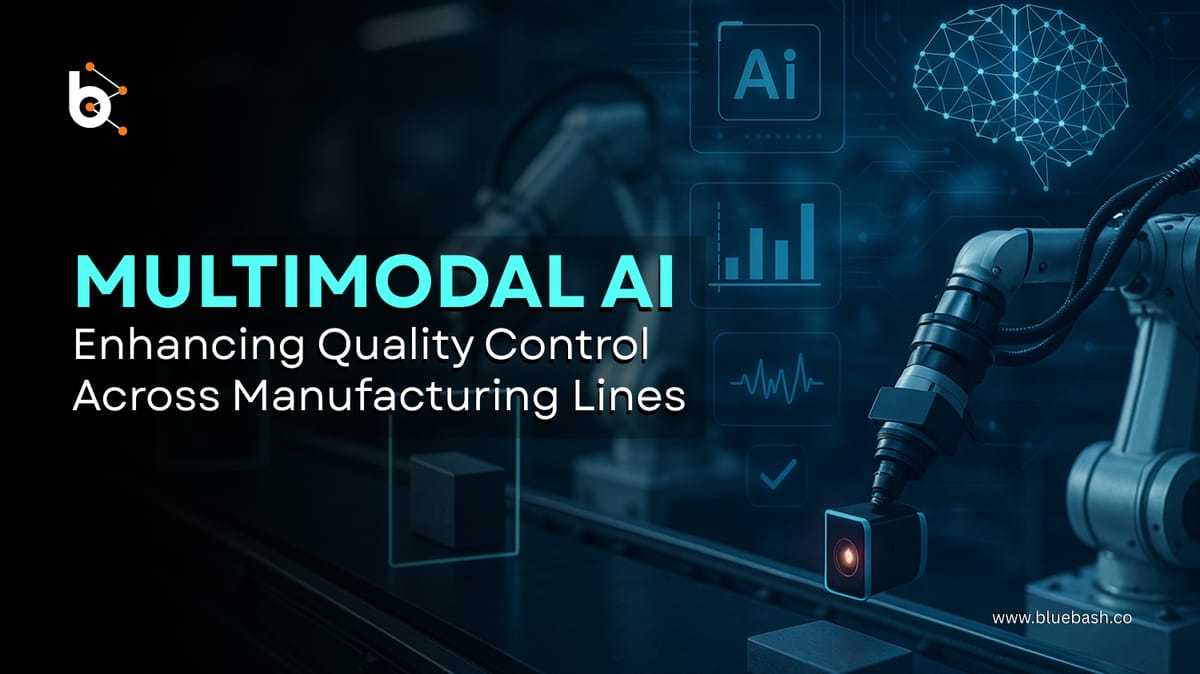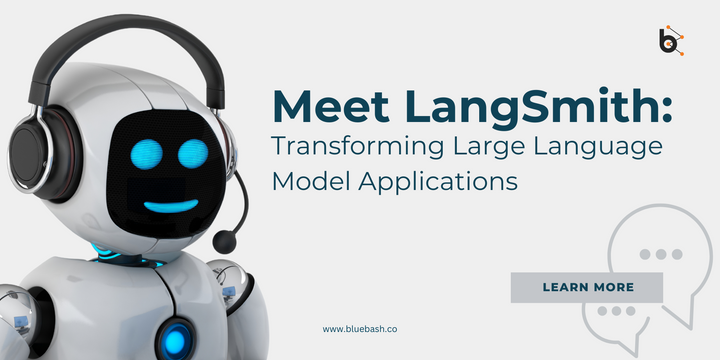How Multimodal AI Enhances Quality Control Across Manufacturing Lines?

Manufacturing has entered a new era, driven by advanced technologies that redefine traditional processes. Among the most transformative innovations is multimodal AI in manufacturing, a cutting-edge approach that combines data from various sources—visual, auditory, thermal, and more—to offer deeper insights and smarter automation.
In the realm of quality control, multimodal AI stands out as a revolutionary force. Manufacturers are increasingly integrating multimodal AI quality control solutions to ensure consistent product standards, reduce defects, and accelerate real-time decision-making. Let’s explore how this powerful form of artificial intelligence is reshaping quality control across manufacturing lines, improving both efficiency and reliability.
Understanding Multimodal AI in Manufacturing
Multimodal AI is an artificial intelligence which can be aware of and interpret information emerging in many data modalities, e.g., images, text, sound, temperature, and sensor readings. This contrasts with classical AI that usually processes one type of input.
In a manufacturing environment, this can include:
- Visual inputs: From cameras for inspection.
- Thermal data: For heat and cooling checks.
- Acoustic signals: For machinery performance and fault detection.
- Sensor data: Including vibrations, pressure, and chemical composition.
By fusing these data types, multimodal AI in manufacturing creates a comprehensive, real-time understanding of every stage of the production process.
The Growing Importance of Quality Control
Quality control is an aspect of production most necessary that directly affects reliability of products, customer satisfaction and quality benchmark. This conventional methods which include simple inspection or erratic testing of sensors are not sufficient because though they give a result with good data cup and real-time response, they do not fit in the demand.
This is where AI for quality control steps in, particularly with multimodal capabilities, to provide enhanced precision, speed, and scalability.
How Multimodal AI Transforms Quality Control ?
- Real-Time Inspection and Defect Detection
Among the most treasured benefits of AI in real-time inspection is that the tool has the capacity to identify flaws in a product in real-time as they are created on the production line.
- Artificial intelligence vision systems examine all the products checking the defects in the quality of the surface, shape, alignment or labeling.
- Thermal cameras will identify the wrong heating or cooling behaviours.
- Vibration and acoustic sensors sense the abnormal pattern in machinery that might threaten the integrity of the products.
When all these inputs are unified through multimodal AI, the system develops an intricate understanding of quality at a microscopic level. It doesn’t just react—it anticipates.
- Cross-Verification Across Modalities
Multimodal AI allows one modality to verify or validate findings from another. For instance:
- If a visual system identifies a crack, a corresponding vibration sensor can confirm mechanical instability.
- Thermal anomalies can be checked against sensor readings to rule out false positives.
This cross-verification minimizes error rates and improves decision accuracy in quality control processes.
- Adaptive Quality Monitoring
AI-powered manufacturing systems become smarter over time. Through machine learning, they adapt to evolving production environments and material behaviors.
- The system learns acceptable tolerances.
- It identifies trends that may indicate gradual quality decline.
- It adjusts parameters without human intervention.
This adaptive capability means manufacturers can detect and correct issues before they affect entire batches, drastically reducing waste and recall risks.
Use Cases of Multimodal AI in Manufacturing Quality Control
- Automotive Industry
Car manufacturers use multimodal AI in manufacturing quality control to inspect engine parts, weld joints, and paint finishes. Systems combine visual inspection with acoustic sensors to ensure engines are assembled without hidden defects. - Electronics Manufacturing
Multimodal AI in PCB (printed circuit board) assembly lines combines information captured by a camera with temperature sensors to provide the right component positioning and solder quality. Any misalignment or overheating triggers an automatic halt and review. - Food & Beverage
Image analysis and odor sensors coupled with temperature checks help AI in quality control by making sure that the product is well packaged, labeled, and fresh. This all-encompassing solution minimizes threats to the health of consumers and boosts their trust. - Pharmaceuticals
Manufacturing of drugs requires extreme accuracy. Multimodal systems can check color disparities, tablet constructions, and observe environmental conditions (such as humidity) simultaneously, ensuring industry compliance and safety.
Benefits of Multimodal AI for Quality Control
- Enhanced Product Quality
Multimodal systems identify flaws which can go unrecognized by single- modality AI. This has a direct lead towards enhanced product regularity, superior quality control and customer satisfaction. - Faster Inspections
AI systems operate in real time, far surpassing human capabilities. The use of AI for real-time inspection significantly shortens production cycles by identifying issues immediately. - Cost Reduction
Multimodal AI quality control helps in reducing rework as well as scrap and warranty claims due to early detection of problems. It also reduces the inspections using hands. - Predictive Maintenance
Combined sensor data assists in predicting failure of equipment. This eliminates breakdowns and helps to lower the cost of unscheduled repair. - Data-Driven Insights
Every inspection generates valuable data. Over time, manufacturers can identify patterns, root causes of defects, and optimize workflows based on AI-driven analytics.
Challenges in Implementing Multimodal AI
Although these benefits are considered, manufacturers can find it difficult to implement multimodal AI:
- High Initial Investment: The total cost of combining cameras, sensors and an AI software can be quite demanding in upfront investments.
- Data Complexity: A lot of multimodal data is produced; it is needed to handle and synchronize the data.
- Talent Gap: The implementation of AI requires the use of specialists in data science, machine learning, and industrial engineering.
However, these barriers are quickly diminishing as technology becomes more accessible and vendors offer end-to-end AI solutions for manufacturing.
Why Choose Bluebash for Multimodal AI in Manufacturing?
Implementing multimodal AI in manufacturing quality control is a complex yet rewarding journey. Choosing the right partner can make all the difference—and that’s where Bluebash comes in.
- Deep Industry Expertise
At Bluebash, we understand the nuances of manufacturing operations. From automotive to electronics and healthcare, we’ve helped businesses automate and optimize their production quality using cutting-edge AI. - Customized AI Solutions
No two factories are alike. Bluebash delivers tailored AI solutions for manufacturing, built to meet your unique infrastructure, production goals, and quality benchmarks. Whether it’s visual inspection integration or multi-sensor orchestration, we develop systems that fit seamlessly. - End-to-End Support
We are with you right from deployment of pilots to full scale implementation. The services of our Artificial Intelligence experts are made available so that your people can find successful integration of Artificial Intelligence, its testing, and training, as well as its further optimization. - Future-Ready Innovation
We constantly invest into R&D to deliver the latest development in the AI-powered manufacturing to our clients. Catching up is one thing but with Bluebash you have your head in the game.

The Future of AI-Powered Manufacturing
In the future, AI-based production will depend on multimodal systems not only in quality assurance tasks, but also in process streamlining, safety track, and chain management. More efficiency gains are possible with closer integration with IoT, cloud-based analytics and digital twins.
The future factory is a self-sustaining self-learning environment where AI in quality control can be considered both a chaperone and a mentor as it can be used to raise the standards of its products without human weakness continuously or variability.
Conclusion
Owing to multimodal AI, the way quality control is conducted within contemporary manufacturing is being redefined. The level of insight into data provided by these intelligent systems is more profound, quicker, and more truthful than ever increased because they combine data from multiple sources and promptly analyze them.
From detecting microscopic defects to preventing equipment failure, the benefits of multimodal AI in manufacturing quality control are undeniable.Since the nature of manufacturing lines is becoming increasingly intelligent, the option of adopting multimodal AI is no longer a choice, it is it a business strategy to pursue the leadership in the product quality and industrial operative efficiency.
Partnering with Bluebash ensures that this transformation is not just effective, but exceptional. With our deep expertise, tailored solutions, and commitment to innovation, Bluebash helps you unlock the full potential of AI for quality control—one intelligent decision at a time.
FAQ's
- What is multimodal AI and how does it apply to manufacturing?
Multimodal AI processes and interprets data from various sources like images, sound, and sensors simultaneously. In manufacturing, it enhances quality control by analyzing these diverse inputs to detect defects, ensure consistency, and automate inspections in real time. - How does multimodal AI improve product quality in factories?
By combining data types, multimodal AI creates a holistic view of each product. It detects minute defects early, enables real-time corrections, and minimizes errors, leading to superior product quality and fewer recalls or customer complaints. - What are the key benefits of using multimodal AI for quality control?
- Real-time defect detection
- Cross-validation across multiple sensors
- Reduced inspection time and costs
- Predictive maintenance and fewer equipment failures
- Valuable analytics for long-term process improvement
- Is implementing multimodal AI costly and complex?
While initial investment and data integration can be challenging, long-term ROI is significant. Costs are decreasing due to better tools, and expert partners like Bluebash simplify deployment with tailored, scalable solutions. - Why should I choose Bluebash for multimodal AI implementation?
Bluebash offers industry-specific AI expertise, fully customized solutions, and end-to-end support. We ensure seamless integration, continuous optimization, and future-ready innovation that aligns perfectly with your manufacturing goals.



